|
|
Lanterns of the Hudson Coal Company
Tom Stranko and Paul Koren
It began in 1837 as a canal builder and eventually became a railroad,
but the Delaware & Hudson Company was first and foremost an anthracite
producer. Its primary product was "hard coal" -- anthracite
-- from the fields of Northeastern Pennsylvania. Introduced as a heating
fuel in the early 1800's, anthracite became increasingly popular for
its efficiency and clean-burning properties. As the market for anthracite
grew, do did the fortunes of the Delaware & Hudson Company. In fact,
the D&H had a real edge over many of its competitors: it not only
owned a number of the mines that produced the mineral but also a transportation
system for bringing it to market. At first the transportation system
consisted of a canal and various inclined planes. In time, the D&H
turned to steam railroads, and by a series of acquisitions became a major
line in the Northeast.
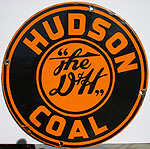 Business
boomed throughout the 1800's, but in the early years of the 20th century
the Delaware & Hudson's competitive advantages caught the attention
of the U.S. Government. This was the era when Teddy Roosevelt and his "trust
busters" attempted to put a stop to price-fixing, business monopolies,
and other practices that were considered bad for competition. The Hepburn
Act of 1906 was the initial shot across the bows of the railroads and
coal mining companies. Essentially the Act banned shipments of coal across
state lines by railroads if that coal had been produced in railroad-owned
mines. Since such shipments were the reason for the Delaware & Hudson's
original existence, the Hepburn Act was a serious threat to the company.
However, a 1909 Supreme Court decision created a legal loophole whereby
a subsidiary -- even if wholly owned by the railroad -- could buy the
coal from a railroad-owned mine and still ship it on that railroad. Thus,
the Delaware & Hudson Company created the Hudson Coal Company as
a subsidiary that became the "owner" of coal from its mines.
Of course the Hudson Coal Company shipped its product on the Delaware & Hudson
Company's railroad. The porcelain sign shown at upper right illustrates
this corporate lineage. The famous "script logo" of the Delaware & Hudson
Company is incorporated into the Hudson Coal Company's logo. Business
boomed throughout the 1800's, but in the early years of the 20th century
the Delaware & Hudson's competitive advantages caught the attention
of the U.S. Government. This was the era when Teddy Roosevelt and his "trust
busters" attempted to put a stop to price-fixing, business monopolies,
and other practices that were considered bad for competition. The Hepburn
Act of 1906 was the initial shot across the bows of the railroads and
coal mining companies. Essentially the Act banned shipments of coal across
state lines by railroads if that coal had been produced in railroad-owned
mines. Since such shipments were the reason for the Delaware & Hudson's
original existence, the Hepburn Act was a serious threat to the company.
However, a 1909 Supreme Court decision created a legal loophole whereby
a subsidiary -- even if wholly owned by the railroad -- could buy the
coal from a railroad-owned mine and still ship it on that railroad. Thus,
the Delaware & Hudson Company created the Hudson Coal Company as
a subsidiary that became the "owner" of coal from its mines.
Of course the Hudson Coal Company shipped its product on the Delaware & Hudson
Company's railroad. The porcelain sign shown at upper right illustrates
this corporate lineage. The famous "script logo" of the Delaware & Hudson
Company is incorporated into the Hudson Coal Company's logo.
Given this history, it's not surprising that Hudson Coal Company markings
can be found on a number of railroad-style lanterns. Shown below are
two examples, a Dietz #39 standard and a Dietz #6 -- both tall-globe,
bellbottom lanterns with "H.C. Co." lettering. The Dietz #39
has a cast D&H logo globe that looks like it was in this lantern
a long time going by the scratches, the rust ring (cleaned now), and
the small round "nick" that someone put in the base of the
globe so it would clear the wick raiser shaft. With the globe in the
lantern and the notch over the shaft, the lid letters and the globe letters
all line up. Hobson's book on lanterns states
that the Dietz #39 Standard model was made from 1888 to 1912 and the
Dietz # 6 from 1902 to 1920. A good estimate for the manufacturing date
of these lanterns would be the years immediately before World War One.
As a side note, the logo on the globe, like the logo within the Hudson
Coal Company sign, says "The D.& H." without "RR" or "railroad".
Before 1899, the actual title of the company was "Delaware & Hudson
Canal Company". In that year, the word "Canal" was dropped,
reflecting the company's recent abandonment of its original canal operations.
Only in 1930 was the word "Railroad" added to the official
name of the corporation.
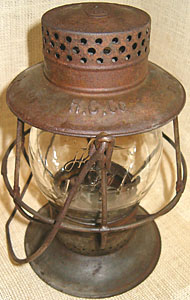 |
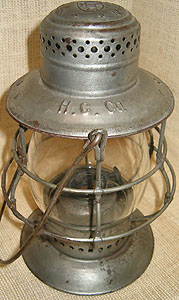 |
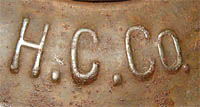 |
 |
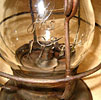 Above
Left. A Dietz #39 Standard lantern with a clear, cast
globe; below that is a close-up of the lettering. At right is a
close up of the Delaware & Hudson "script" logo cast
globe. Click on the image for a larger version. Above Right. A
Dietz #6 lantern with a clear, unmarked globe. Above
Left. A Dietz #39 Standard lantern with a clear, cast
globe; below that is a close-up of the lettering. At right is a
close up of the Delaware & Hudson "script" logo cast
globe. Click on the image for a larger version. Above Right. A
Dietz #6 lantern with a clear, unmarked globe. |
The anthracite business was strong through the early decades of the
20th century but collapsed after World War Two as alternative fuels such
as oil and natural gas captured the domestic heating market. After years
of unprofitability, the Hudson Coal Company was finally sold in 1960
to the Blue Coal Corporation of Maine, a subsidiary of the Glen Alden
Corporation. At that time all underground mining activities were suspended,
although other processing operations continued to generate shipments
for its former owner, at least for a while.
And the railroad itself? The Delaware & Hudson Railroad, having
lost its original reason for existing, struggled to redefine itself as
a bridge route for a number of decades. It declared bankruptcy in the
1980's and was finally acquired by Canadian Pacific Railway in 1990.
But the news isn't all bad. In late 2004, Canadian Pacific announced
a new cooperative agreement with Norfolk Southern to route a lot of new
traffic over the former Delaware & Hudson lines. So while the Hudson
Coal Company era belongs to historians and collectors, the old Delaware & Hudson
Railroad continues on into railroading's future.
Sources. "Delaware & Hudson" (1982) by
Jim Shaughnessy, Howell-North Books; "A History of the Delaware & Hudson
Company" (1923) published by the company. Also see the website of
the Bridge Line Historical Society.
Postscript. A visitor to this page sent the following
comment: "
My great grandfather worked for the Hudson Coal Co. His name
is William Jenkin. There is a piece of coal that is 13,600 lbs that
he and another man brought out of the coal mine. It is at the
Wayne County Historical Society in Honesdale, PA." See
picture. |